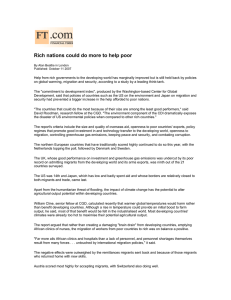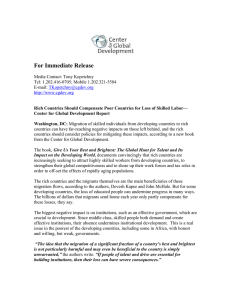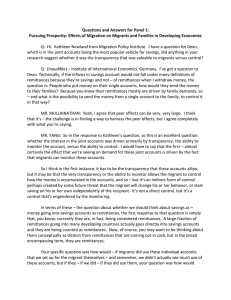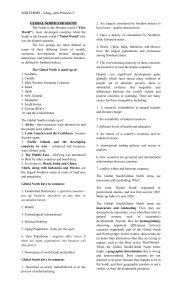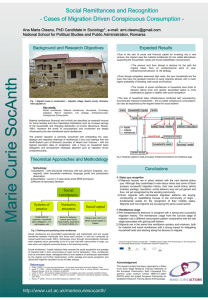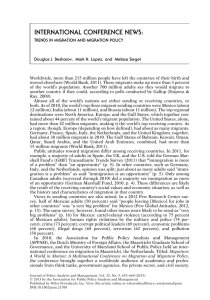Discussion: José Antonio Ocampo, “International Migration” World Economic and Social Survey 2004
advertisement
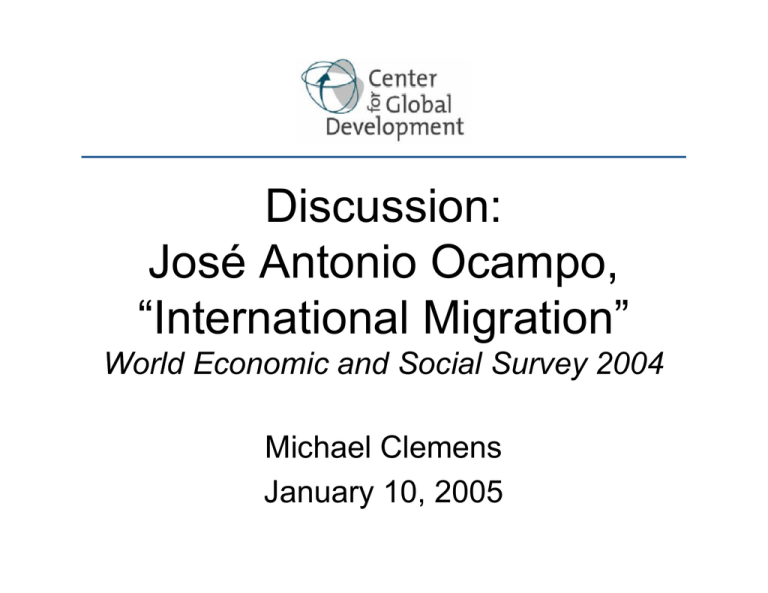
Discussion: José Antonio Ocampo, “International Migration” World Economic and Social Survey 2004 Michael Clemens January 10, 2005 Outline 1. Things I learned 2. Quibbles of substance 3. Policy recommendations • Questioning what’s there… • …and what isn’t 4. Research agenda sketch 1. (Some) things I learned • Poor haven’t moved, and won’t move – 1995-2000: For every 10,000 in LDCs, 167 are born, 6 move to rich countries – Africa til 2050: 1% of increase moves • Knowledge transfer from poor to rich – 70% of FDI flows to China originate from Chinese community abroad 2. Quibbles of substance • “[N]o radical or widespread shifts in policy are anticipated.” – Forces moving skilled will continue (aging, tech. change, globalization) – But: Policy, not fundamentals, blocked post WWI movement of unskilled – Similar today: Greater restrictiveness, required migration rates too high 2. Quibbles of substance • “Improving human well-being in the developing countries … should … reduce the large numbers of people who would emigrate if they had the opportunity.” – Hatton and Williamson: In poorest countries (European periphery 1800s, Africa today) income ↑ → migration ↑ 3. Policy recommendations Report: 3 types of recommendations a) Improve conditions for migrants in destination country b) Increase benefits and reduce costs to countries of origin c) Improved international cooperation 3. Policy recommendations General comments • Priorities • Justification for public action • Consistency • Destination country political economy a) Conditions for migrants • Rich countries should educate and train migrants – Increased incentives to move? • Governments should actively combat xenophobia – What about increasing flows? – 78% of Germans against; they’re wrong? Domestic compensation of losers? • Make retirement benefits portable • Recognize more asylum seekers b) Net benefit to origin country • Decrease transaction cost of sending remittances – Development impact unclear • Support hometown associations and business/academic networks – How? If migrants don’t know which businesses and development projects to fund, how should we? b) Net benefit to origin country • Policies to facilitate return migration – Evidence it’s inefficiently low? – McKinsey FDI study • Promote LDC exports to migrant/diaspora customers – Picking winners; diaspora doesn’t know what it wants, but we do b) Net benefit to origin country • Allow migrants to participate in political life of origin countries – Representation without taxation acceptable to origin countries? • Destination countries should ensure they don’t take a “critical proportion” of skilled workers – Thus block all African professionals?? b) Net benefit to origin country • Destination countries should defray training costs of skilled migrants – Elsewhere you slam this as ‘incoherent’ – In poorest countries, this can increase migration. b) Net benefit to origin country • Countries of origin should train more personnel in areas where there is an excessive outflow – If there are opportunities for Malawian nurses, why aren’t more Malawians becoming nurses? And if there aren’t opportunities, should Malawi produce a bunch of unemployed graduates? c) International cooperation • Achieve the MDGs • Rich countries should make migration policy a consistent part of their development policy – ‘Consistency’ complex – Development impact of mass movement limited – Focus on key nodes: Taiwanese tech. parks, Berkely Mafia, etc. c) International cooperation • Better data – Definitely! • Sign and ratify the International Convention on the Protection of the Rights of All Migrant Workers and Members of their Families. – But not a single rich country has done so in the 15 years since 1990 Not in the report • • • • • • Let in more unskilled (effect limited) Tax revenue sharing Taxation of diaspora (Eritrea) Temporary return of skilled workers Shift to less distortionary tariff-like barriers Long-run solution: either 1) institutional development in sending countries, or 2) ghost countries "The last refuge of a social-scientific scoundrel is to call for more research. Nevertheless, I cannot forbear from suggesting some further lines of inquiry." —Robert Putnam, Bowling Alone 4. Research agenda sketch • Document gains (beyond CGE) • Development impact of returning migrants, remittances, etc. • Feasibility of occupation-based quotas • Case studies of existing temporary schemes 4. Research agenda sketch • Limits to political feasibility • Effects of migration option on human capital investment • China sent 580,000 students overseas between 1979 and 1999, of which 25% had returned by 2002. Is this “enough”? 4. Specific issues for temporary labor movement schemes • How to certify labor “shortage”? • What to do with overstayers? – Ineffective in EU – Would require elimination of naturalization programs – Remittances held in escrow? 4. Specific issues for temporary labor movement schemes • One fourth of US immigrants illegal • No negotiating partner: Somalia • Canada, Germany, UK, US, Australia, Gulf States, Thailand, Singapore, many others have had such programs. Successes?
